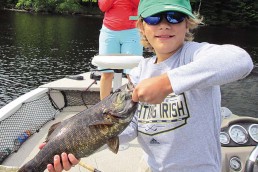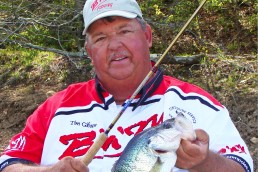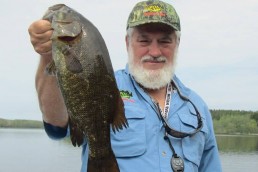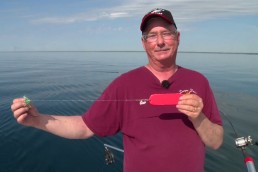Target Transitions for Big Spring Smallmouths
SHARE THIS POST
Transition areas can be prime staging areas for big pre-spawn females. As water temperatures rise during the day, females will start to roam the shallows and continue doing so until the sun wanes. Once the water temperatures drop a few degrees, the female smallmouths begin to move. As they move out they’ll stack up along the first transition from soft to hard bottom on many lakes or reservoirs, and usually at a steep rock shoreline.
Big smallmouths hold tightly to steep rock transitions overnight and remain there the next day until the water temperatures repeat their changes. Even if the transition is not present, smallmouths will use the steeper rock banks as migration routes from deep to shallow water. Most anglers launch their boats and head into these shallows and pass up the honey hole. The smart angler will stop at the transition, cast a suspending jerkbait, soft plastic jerkbait, grub, jig and minnow or a crankbait and start the day with catching big ones.
Don’t make the same mistake and pass up the transition in the morning, as you might catch a few small males while fishing the shallows, and might even have some fun, but if the water temperature drops overnight, those bigger fish will not be there. If you wait to fish the transition until late morning you may also find a lack of big fish. But as the day progresses and the water temperatures rise a few degrees these conditions will trigger those smallmouths to head back toward the shallows. This might not be a quick movement and fish will spread out and be tough to locate, but they will come.
By late afternoon, smallmouths are back suspending off the edge of a transition area and are catchable. The first time I caught a large smallmouth relating to a transition was in the afternoon when the bite in the shallows had stopped. I had about an hour left on a guide trip and decided to give a steep rocky shoreline a try even though I’d fished it several times before during the day with little success. I had my client cast a crankbait, hoping to kill some time before heading back to the boat landing, and then after the third cast, he connected with a 20-incher, the largest smallmouth of the day. No, I did not keep the big fish for last, even though my client might have thought that.
At first I did not dwell on this, thinking that my client had managed to stumble into a “gift fish.” I had the guy booked for the next day. And, how could we not make the place where he had caught the big fish the day before our first stop? I was hoping that there would be at least one big smallmouth, but to my surprise, my client boated five more smallmouths in the 20-inch class. I even got into the act and caught a 20-incher with a grub. Since that time that transition, along with a few others, are a regular morning and afternoon stop on my guided trips.
Are you enjoying this post?
You can be among the first to get the latest info on where to go, what to use and how to use it!
When the water temperatures climb into the upper 50s or low 60s, smallmouths enter the late pre-spawn period. At that time, plastics and jerkbaits remain effective, but topwater baits get even more. But fishing with a topwater bait is never a guarantee. Closer to spawn, the topwater bite can be sporadic and you will need to make adjustments. When using topwater baits in spring, find the proper retrieve.
Unlike summer, when smallmouths strike a variety of retrieves, in spring they can be very selective. For example, one early spring day I was fishing on the Menominee River with a new client. We had caught several quality smallmouths on a combination of soft plastics and jerkbaits off a rock/sand transition adjacent to an island. At midday, my client inquired about the possibility of catching smallmouths on top. I told him let’s give it a try since the water temperature was on the rise and the smallmouths were on the move. We cautiously approached the island and I pointed to a point on the south end of the land and gave my client a 4-inch Bone Shad Hubs Chub. I instructed him to cast the Hubs Chub tight to the shoreline, let the lure sit a few seconds, and then pull the lure about 1 foot and let the rear of the bait drop vertically. I stressed it was important not to pull the lure too far and to let it sit about five seconds before continuing the retrieve.
For whatever reason, my client couldn’t get it just right, although he did manage to get a few strikes. He may have either pulled the lure too far or did not let it pause long enough. He was fishing in the front of the boat, and after about 10 minutes I began casting a 4-inch frog pattern Chub from the rear casting deck hoping to stick a few smallmouths. I then suggested that my client refrain from casting and watch closely how I was working the bait. I made about six casts and my client watched patiently, asking a few questions along the way. Finally, the water exploded as we approached the north end of the island. My client had said that the fish inhaled the lure after it sat for a few seconds. It was a big 22-inch pre-spawn female. Eventually, my client did master the retrieve and caught a few big smallmouths with the same topwater bait and presentation. After I caught that one my client had no trouble letting the lure pause and drop.
Spring smallmouths action can be consistent if you target transitions early and late. If you are lucky and the weather is stable and water temperatures rise by midday, go and bring out the topwater lures.
MWO
SHARE THIS POST
Did you enjoy this post?
You can be among the first to get the latest info on where to go, what to use and how to use it!
Mike Mladenik
Mike Mladenik has been guiding for more than 30 years in Northern Wisconsin. Recognized as one of the top smallmouth bass experts in North America, he has boated 4,000+ smallmouth over 5 pounds and a few hundred over 6 pounds. Mike has authored 10 fishing books and gives seminars at sports shows across the Midwest. For more info: bigsmallmouthbass.com or 715-854-2055.



